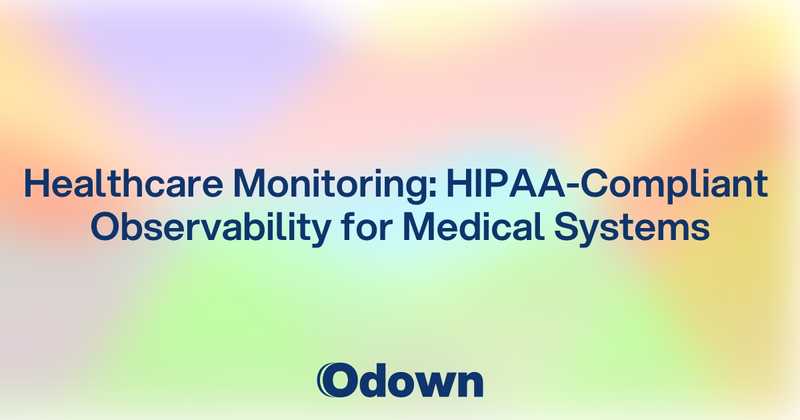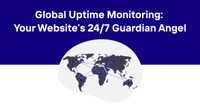Healthcare Monitoring: HIPAA-Compliant Observability for Medical Systems
Your hospital's electronic health record system went down during morning rounds. Doctors couldn't access patient histories. Nurses couldn't update medication records. Lab results disappeared into digital limbo. For three hours, your state-of-the-art medical facility operated like it was 1985, with paper charts and handwritten notes.
But the real problem wasn't the technical failure - it was what you discovered afterward. Your monitoring system had captured detailed logs of the outage, but those logs contained patient names, medical record numbers, and treatment information. Your attempt to diagnose the technical problem had created a potential HIPAA violation that could result in massive fines and legal liability.
Healthcare monitoring presents unique challenges that don't exist in other industries. Every system failure potentially affects patient care and safety. Every monitoring log might contain protected health information (PHI) that requires special handling. Every security incident could expose sensitive medical data that affects patient privacy and organizational liability.
HIPAA Compliance in Monitoring: Privacy and Security Requirements
Healthcare monitoring must balance comprehensive system visibility with strict privacy regulations that limit how patient data can be collected, stored, and accessed.
Protected Health Information (PHI) in Monitoring Data
Healthcare monitoring systems often capture data that contains or could reveal protected health information, requiring careful handling to maintain HIPAA compliance.
Log sanitization processes must remove or encrypt PHI from monitoring data while preserving information needed for system troubleshooting and performance optimization.
Database monitoring requires special consideration because database logs often contain actual patient data that was part of queries, updates, or error conditions.
Application monitoring in healthcare systems must account for PHI that appears in error messages, debug logs, and performance traces that capture application state.
Network monitoring can inadvertently capture PHI transmitted between systems, requiring encryption and access controls that protect patient privacy.
User activity monitoring must track system access and usage patterns for security purposes while protecting patient privacy and avoiding unnecessary collection of PHI.
Access Control and Audit Requirements
HIPAA requires comprehensive tracking of who accesses patient information and monitoring systems that contain or process PHI.
Role-based access control for monitoring systems ensures that only authorized personnel can access monitoring data that might contain PHI.
Audit logging tracks all access to monitoring systems and monitoring data to provide the comprehensive audit trails that HIPAA requires.
Minimum necessary standards require that monitoring access is limited to the minimum information necessary for specific job functions or troubleshooting needs.
Business associate agreements must cover third-party monitoring services that might have access to PHI through monitoring data or system access.
Data retention policies for monitoring data must comply with HIPAA requirements while supporting operational needs for troubleshooting and performance analysis.
Security Monitoring and Incident Response
Healthcare security monitoring must detect threats to patient data while maintaining compliance with privacy regulations during incident response.
Breach detection monitoring identifies unauthorized access to patient data and triggers HIPAA-compliant incident response procedures.
Risk assessment monitoring continuously evaluates security controls and identifies vulnerabilities that might expose PHI to unauthorized access.
Incident documentation must balance thorough incident analysis with privacy protection requirements when incidents involve PHI exposure.
Notification requirements mandate specific procedures and timelines for reporting security incidents that might affect patient privacy.
Data Encryption and Protection
Healthcare monitoring data often requires encryption both in transit and at rest to protect any PHI that monitoring systems might capture.
Encryption key management for monitoring systems must follow healthcare security standards and provide appropriate access controls.
Secure transmission of monitoring data between systems requires encryption that protects PHI while enabling operational monitoring workflows.
Data masking techniques can protect PHI in monitoring data while preserving information needed for system analysis and troubleshooting.
Backup and recovery procedures for monitoring data must maintain encryption and access controls that protect patient privacy.
Electronic Health Record (EHR) System Monitoring
EHR systems represent critical infrastructure for healthcare delivery and require specialized monitoring that ensures availability, performance, and data integrity.
EHR Performance and Availability
EHR system availability directly affects patient care quality and safety, making uptime monitoring a patient safety issue rather than just a technical concern.
Response time monitoring for EHR systems must account for clinical workflow requirements where delays can affect patient care decisions.
Database performance monitoring for EHR systems requires special attention because database issues often manifest as slow clinical workflows rather than obvious system failures.
Integration monitoring between EHR systems and other healthcare applications ensures that clinical data flows correctly between systems used for patient care.
User session monitoring tracks healthcare provider interactions with EHR systems to identify usability issues that might affect clinical efficiency.
Clinical decision support monitoring ensures that alerts, reminders, and clinical guidelines function correctly within EHR workflows.
EHR Data Integrity and Accuracy
Healthcare data integrity monitoring ensures that patient information remains accurate and complete throughout EHR system operations.
Data validation monitoring checks for inconsistencies, missing information, and data quality issues that might affect clinical decision-making.
Backup and recovery monitoring for EHR systems must ensure that patient data can be restored accurately without data loss that could affect patient care.
Interface monitoring tracks data exchange between EHR systems and laboratory systems, pharmacy systems, and other clinical applications.
Version control monitoring ensures that EHR system updates and configuration changes don't introduce data integrity issues.
Audit trail monitoring tracks all changes to patient records and ensures that clinical documentation maintains proper attribution and timestamps.
EHR Security and Privacy
EHR security monitoring must protect patient data while enabling the system access that healthcare providers need for patient care.
Authentication monitoring tracks user login attempts and identifies potential unauthorized access to patient records.
Authorization monitoring ensures that healthcare providers only access patient records appropriate to their role and current patient assignments.
Data access monitoring tracks which patient records are accessed by whom and when to support HIPAA audit requirements.
Privileged access monitoring tracks administrative access to EHR systems and ensures that system administrators follow appropriate procedures for accessing patient data.
EHR Compliance and Reporting
EHR monitoring must support various compliance requirements including meaningful use criteria and quality reporting measures.
Meaningful use monitoring tracks EHR system usage patterns to ensure compliance with CMS meaningful use requirements for Medicare and Medicaid incentive programs.
Quality measure monitoring tracks clinical quality metrics that rely on EHR data to support value-based care reporting requirements.
Interoperability monitoring ensures that EHR systems can exchange data with other healthcare systems as required by interoperability regulations.
Clinical documentation monitoring tracks the completeness and timeliness of clinical documentation within EHR systems.
Telemedicine Platform Reliability and Performance Monitoring
Telemedicine systems require specialized monitoring that ensures reliable healthcare delivery through remote communication technologies.
Video Conferencing and Communication Quality
Telemedicine relies heavily on video and audio quality that directly affects clinical communication and patient care quality.
Video quality monitoring tracks resolution, frame rates, and compression artifacts that might affect clinical visual assessment capabilities.
Audio quality monitoring ensures clear communication between providers and patients, which is essential for clinical history-taking and patient education.
Latency monitoring tracks communication delays that might affect real-time clinical interactions and emergency consultations.
Bandwidth utilization monitoring ensures that telemedicine platforms can deliver adequate quality across different network conditions and user locations.
Connection reliability monitoring tracks session completion rates and identifies technical issues that interrupt clinical consultations.
Telemedicine Platform Availability
Telemedicine platform outages can prevent access to healthcare services, making availability monitoring a patient access issue.
Scheduled appointment monitoring ensures that telemedicine systems are available during planned clinical appointments.
Emergency consultation monitoring provides higher availability requirements for telemedicine systems used for urgent clinical situations.
Mobile application monitoring tracks telemedicine app performance across different devices and operating systems used by patients.
Web portal monitoring ensures that browser-based telemedicine access works reliably across different platforms and configurations.
Patient Data Security in Telemedicine
Telemedicine platforms transmit sensitive patient information that requires comprehensive security monitoring and protection.
End-to-end encryption monitoring ensures that video, audio, and data transmissions between patients and providers remain secure.
Patient authentication monitoring tracks how patients verify their identity when accessing telemedicine services.
Provider authentication monitoring ensures that healthcare providers are properly authenticated when delivering care through telemedicine platforms.
Recording and storage monitoring tracks how telemedicine sessions are recorded, stored, and protected in compliance with HIPAA requirements.
Session monitoring tracks who participates in telemedicine consultations and ensures appropriate clinical supervision and oversight.
Telemedicine Integration Monitoring
Telemedicine platforms often integrate with EHR systems and other healthcare applications, requiring monitoring of data exchange and workflow integration.
EHR integration monitoring ensures that telemedicine consultations are properly documented in patient medical records.
Prescription system integration monitoring tracks electronic prescribing capabilities within telemedicine workflows.
Laboratory and imaging integration monitoring ensures that test results are available during telemedicine consultations when clinically appropriate.
Billing system integration monitoring tracks how telemedicine services are documented and billed for insurance and payment processing.
Healthcare IoT Device Monitoring: Connected Medical Equipment
Internet of Things (IoT) devices in healthcare require specialized monitoring approaches that account for patient safety implications and regulatory requirements.
Medical Device Performance Monitoring
Connected medical devices require monitoring that ensures device accuracy, reliability, and patient safety.
Device calibration monitoring tracks medical device accuracy and identifies when devices require recalibration or maintenance.
Battery and power monitoring for portable medical devices ensures that devices remain operational when patients depend on them.
Sensor accuracy monitoring validates that medical sensors provide accurate readings that support clinical decision-making.
Device connectivity monitoring tracks network connections for medical devices and identifies communication issues that might affect device functionality.
Firmware update monitoring ensures that medical device software updates install correctly and don't introduce safety issues.
Patient Monitoring Systems
Remote patient monitoring devices require comprehensive observability to ensure patient safety and clinical effectiveness.
Vital sign monitoring tracks the accuracy and reliability of remote patient monitoring devices that capture heart rate, blood pressure, and other clinical parameters.
Alert system monitoring ensures that clinical alerts from patient monitoring devices reach healthcare providers reliably and promptly.
Data transmission monitoring tracks how patient data moves from monitoring devices to clinical systems and identifies transmission failures.
Device compliance monitoring ensures that patient monitoring devices remain properly configured and calibrated for individual patient needs.
Battery life monitoring for patient devices ensures that monitoring continues uninterrupted and provides advance warning of device maintenance needs.
Healthcare IoT Security
Connected medical devices create unique security challenges that require specialized monitoring approaches.
Device authentication monitoring ensures that only authorized medical devices can connect to healthcare networks and systems.
Network segmentation monitoring isolates medical devices from other network traffic to reduce security risks and improve device reliability.
Vulnerability monitoring tracks security vulnerabilities in medical device firmware and software and identifies devices that require security updates.
Unauthorized access monitoring detects attempts to tamper with or gain unauthorized access to medical devices.
Data encryption monitoring ensures that medical device communications use appropriate encryption to protect patient data.
Regulatory Compliance for Medical Devices
Healthcare IoT monitoring must support FDA and other regulatory requirements for connected medical devices.
FDA reporting monitoring tracks medical device performance and identifies adverse events that require regulatory reporting.
Quality system monitoring ensures that medical device monitoring supports quality management system requirements.
Risk management monitoring tracks medical device risks and ensures that monitoring data supports ongoing risk assessment and mitigation.
Clinical evidence monitoring tracks how medical device performance data supports clinical effectiveness and safety evidence.
Healthcare monitoring transforms patient care technology from isolated systems into integrated, observable platforms that support safe, effective healthcare delivery. Instead of hoping that critical systems work properly, healthcare organizations get comprehensive visibility into the technology infrastructure that patient care depends on.
The investment in comprehensive healthcare monitoring pays dividends in improved patient safety, regulatory compliance, and operational efficiency that enables healthcare organizations to focus on their primary mission of delivering excellent patient care.
Ready to implement HIPAA-compliant healthcare monitoring? Odown provides healthcare-grade monitoring with the security, privacy, and compliance capabilities that medical systems require. Combined with our financial services monitoring expertise, you'll have the monitoring foundation needed for highly regulated industries where system reliability directly affects human welfare and organizational liability.



